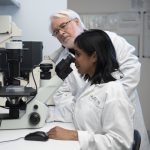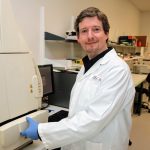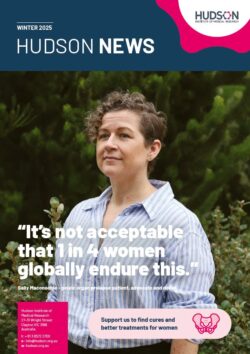Infertility
One in six Australian couples faces infertility challenges. The causes are complex but evenly distributed
- One-third to female factor
- One-third to male factors
- One-third involving both partners or unknown causes.
The personal emotional and financial tolls of infertility are significant. Along with the substantial cost to the Australian healthcare system, the multi-faceted burden of infertility underscores the need for comprehensive medical care, emotional support systems and research, to improve outcomes for families.
How medical research is helping
Hudson Institute’s infertility researchers investigate the causes of male and female fertility with the goal of improving diagnosis and treatments for infertility. Their expertise encompasses genetics, epigenetics (gene expression regulation), the immune system and environmental factors on fertility. Our infertility researchers are also exploring how current treatments might impact future generations.
Leading research breakthroughs
Hudson Institute scientists have made significant contributions to reproductive health and fertility breakthroughs. Our scientists pioneered IVF technologies responsible for the birth of seven million babies worldwide, including the use of fertility drugs to time ovulation, systems for egg collection and embryo donation, and techniques for egg and embryo freezing.
Infertility research projects underway
Epigenetic and environmental impacts on reproductive health and fertility

 The study of epigenetics shows how experiences can impact genes and future generations. Epigenetics is like a control system for genes. While your DNA contains all the genetic instructions, epigenetic marks determine which genes are active or inactive at any given time. These marks can be influenced by your lifestyle and environment, such as what you eat or the stress you experience. Interestingly, some epigenetic changes can be passed down to children, potentially affecting their health and development.
The study of epigenetics shows how experiences can impact genes and future generations. Epigenetics is like a control system for genes. While your DNA contains all the genetic instructions, epigenetic marks determine which genes are active or inactive at any given time. These marks can be influenced by your lifestyle and environment, such as what you eat or the stress you experience. Interestingly, some epigenetic changes can be passed down to children, potentially affecting their health and development.
The Western team are investigating
- The impact of environmental agents and anti-cancer drugs on fertility and male and female health.
- The role of ovarian function, egg growth and steroid production on female fertility.
- How testis function and steroid production affect male fertility
Lead researcher | Professor Patrick Western, Dr Ellen Jarred
Epigenetic impacts on inherited disease and offspring health

 This research explores how epigenetic factors regulate egg programming and the health of the offspring. The team studies the effects of environmental agents and anti-cancer drugs on egg quality and subsequent generations. By uncovering these mechanisms, researchers aim to identify potential risks and improve outcomes for offspring conceived through assisted reproductive technologies or by parents exposed to environmental or medical factors.
This research explores how epigenetic factors regulate egg programming and the health of the offspring. The team studies the effects of environmental agents and anti-cancer drugs on egg quality and subsequent generations. By uncovering these mechanisms, researchers aim to identify potential risks and improve outcomes for offspring conceived through assisted reproductive technologies or by parents exposed to environmental or medical factors.
Lead researcher | Professor Patrick Western, Dr Ellen Jarred
Immune-reproductive interplay in male fertility

 This project investigates the relationship between the immune system and male fertility. The team aims to identify key signalling molecules and cell types in sperm development, focusing on testicular and immune cell interactions that regulate sperm and hormone production. They also aim to uncover the risk factors for immunological infertility by mapping testicular immune cell dynamics from fetal development to adulthood with the goal to develop ways to preserve male fertility.
This project investigates the relationship between the immune system and male fertility. The team aims to identify key signalling molecules and cell types in sperm development, focusing on testicular and immune cell interactions that regulate sperm and hormone production. They also aim to uncover the risk factors for immunological infertility by mapping testicular immune cell dynamics from fetal development to adulthood with the goal to develop ways to preserve male fertility.
Collaborators | Justus-Liebig University, Germany
Team | Dr Rukmali Wijayarathna, Professor Kate Loveland, Professor Mark Hedger
How events during fetal development and infancy contribute to adult infertility

 Molecular studies Researchers are examining how fetal exposure to pre-eclampsia, inflammation and medications affect testis development and adult fertility. The team has identified key proteins enabling normal development and cell communication between sperm precursors and testicular support cells. Through national and international collaborations, they are also looking at how these signalling mechanisms function and malfunction, potentially leading to testicular tumours and infertility.
Molecular studies Researchers are examining how fetal exposure to pre-eclampsia, inflammation and medications affect testis development and adult fertility. The team has identified key proteins enabling normal development and cell communication between sperm precursors and testicular support cells. Through national and international collaborations, they are also looking at how these signalling mechanisms function and malfunction, potentially leading to testicular tumours and infertility.
Team | Professor Kate Loveland, Professor Mark Hedger, A/Prof Robin Hobbs, Dr Sarah Moody, Dr Penny Whiley, Iris Ma
Health and fertility of young men conceived using intra-cytoplasmic sperm injection (ICSI)

 The Monash Male DNA Infertility Repository, led by Professors McLachlan and Professor Moira O’Bryan, University of Melbourne, collaborates with scientists and clinicians from leading international centres and programs with the aim of establishing the genetic origins of male infertility.
The Monash Male DNA Infertility Repository, led by Professors McLachlan and Professor Moira O’Bryan, University of Melbourne, collaborates with scientists and clinicians from leading international centres and programs with the aim of establishing the genetic origins of male infertility.
Lead researcher | Professor Robert McLachlan AM
Understanding the role of stem cells in male fertility


Molecular studies This research focuses on spermatogonial stem cells (SSCs), which are crucial for sperm production in the testis. The project aims to explain how SSCs are regulated and their role in maintaining fertility and repairing testicular tissue. By investigating these fundamental processes, the team seeks to gain insights into male reproductive biology. This knowledge could potentially lead to new approaches for treating male infertility and improving reproductive outcomes, especially in cases where sperm production is compromised.
Team | Associate Professor Robin Hobbs, Dr Rheannon Blucher, Bianka Su Stephanie Cheng
Infertility: causes, risks, diagnosis, treatments and when to seek help
What is infertility?
Infertility is defined as the inability to conceive after one year of regular unprotected sexual intercourse. For couples trying to conceive, approximately 85 per cent achieve pregnancy within the first year. By the end the second year, about 95 per cent of couples successfully conceive. Couples are typically advised to seek medical advice if they haven’t conceived after a year.
Female infertility
Why is infertility so prevalent?

Infertility’s prevalence stems from the complex biological processes required for pregnancy. The reproductive journey involves several critical steps
- Ovary releases a mature egg
- Egg travels into the fallopian tube
- Sperm navigate through the cervix, uterus, and into the fallopian tube
- Sperm fertilizes the egg
- Fertilized egg moves down the fallopian tube to the uterus
- Fertilized egg implants in the uterus and begins to grow
Any disruption in this delicate sequence can result in infertility, highlighting the complexity and sensitivity of the reproductive process.
What causes infertility in women?

Female infertility is complex can stem from various factors
- Ovulation disorders
-
- Primary Ovarian Insufficiency: Reduced ovarian function – the cause is unknown in about 90 per cent of cases.
- Polycystic Ovary Syndrome (PCOS): A condition where excess male hormones impede conception.
- Age-related factors
-
- Natural decline in egg quantity and quality after age 35.
- Delayed childbearing, which increases relevance as women age.
- Other potential causes
-
- Implantation issues
- Blocked fallopian tubes due to scar tissue from conditions such as endometriosis, pelvic inflammatory disease, or previous surgeries, such as ectopic pregnancy
- Structural problems e.g fibroids
- Medical conditions e.g. autoimmune diseases and endometriosis can affect fertility
- Failure of egg maturation
- Unexplained infertility
-
- No specific cause identified in approximately one-third of cases
What are the risk factors for female infertility?

Several lifestyle, health, and environmental factors can influence fertility
- Age Women over 35 may produce fewer, lower-quality eggs.
- Smoking Can damage reproductive organs and increase risks of ectopic pregnancy, and miscarriage.
- Substance use Illegal drugs and excessive alcohol can impair fertility.
- Weight Being over or underweight can affect ovulation and menstrual cycles.
- Sexual health Sexually transmitted infections (STIs) can cause fallopian tube inflammation and scarring.
- Stress Excessive physical or emotional stress may affect hormonal balance and ovulation.
- Environmental exposure Pesticides, solvents and heavy metals in the workplace or environment may contribute to infertility.
- Medical conditions Certain diseases or disorders can impact reproductive health.
How can women improve their fertility?

Lifestyle adjustments can support reproductive health and the chances of pregnancy.
- Maintaining a healthy weight Both overweight and underweight conditions can affect fertility.
- Adopting a balanced diet Rich in vitamins, minerals, and antioxidants.
- Quit smoking Protects reproductive health and reduces risks of ectopic pregnancy and miscarriage.
- Limit alcohol Excessive alcohol consumption can impair fertility.
- Manage stress Practice mindfulness, meditation, or regular exercise for hormonal balance.
- Moderate caffeine intake High levels may interfere with fertility.
- Time intercourse Have sex every two to three days, especially near ovulation.
- Track ovulation Use ovulation prediction kits or basal body temperature charting.
- Seek timely medical advice Consult a healthcare provider if struggling to conceive.
How is the cause of female infertility diagnosed?

These diagnostic tests help identify underlying factors contributing to infertility in women.
- Blood tests Assess hormone levels, indicating ovulation or hormonal imbalances.
- Ultrasound scans Examine reproductive organs for abnormalities like ovarian cysts or uterine fibroids.
- Laparoscopy Surgical procedure allowing direct visualisation of reproductive organs, useful for detecting endometriosis, scar tissue, or structural abnormalities.
- Physical examinations Include pelvic exams to assess reproductive organ health.
- Hysterosalpingography X-ray procedure to check fallopian tube patency (openness) and uterine shape.
- Ovulation testing Uses urine or blood tests to confirm ovulation.
- Genetic testing Identifies potential inherited disorders affecting fertility.
What are treatments for female infertility?

Treatments vary depending on the underlying cause and may include
- Surgical procedures to correct anatomical issues like blocked fallopian tubes or remove ovarian cysts.
- Hormone therapy Balance hormones to regulate ovulation and improve fertility.
- Assisted Reproductive Technologies (ART) Include in vitro fertilisation (IVF).
- Ovulation induction Medications to stimulate egg production.
- Intrauterine insemination (IUI) Placing sperm directly into the uterus.
- Lifestyle modifications Weight management, stress reduction and nutritional improvements.
- Fertility preservation Egg or embryo freezing for future use.
When to seek help for fertility issues

- People under 35 years Seek help after one year of unsuccessful attempts to conceive
- People 35 years and older Consult a healthcare provider after six months
- Women with known health conditions Seek help help, especially with conditions like endometriosis, PCOS, history of pelvic inflammatory disease, irregular or painful periods, previous miscarriage.
- Any age Consult immediately if there’s a history of genetic disorders or known fertility problems.
Male infertility
What is male infertility?

Issues with sperm production, quality, or delivery can impact fertility outcomes in men.
Successful male reproduction depends on
- Producing healthy sperm Essential for fertilisation.
- Achieving erection and ejaculating Necessary for delivering sperm to the female reproductive tract.
- Adequate sperm count and motility Crucial for successful fertilisation.
- Normal sperm morphology Impacts the sperm’s ability to fertilise the egg.
What causes male infertility?

Male infertility can result from various factors, including
- Blockages Obstructions in sperm transport pathways.
- Sperm production issues Low sperm count (oligospermia), absence (azoospermia), poor motility, or abnormal morphology.
- Functional problems Erectile dysfunction or ejaculation difficulties.
- Inflammatory conditions STIs or other illnesses affecting reproductive organs.
- Immunological disorders Immune system targeting sperm cells.
- Injuries Trauma to reproductive organs.
- Chronic health conditions Diabetes, obesity or hormonal imbalances.
- Medications Including certain drugs, alcohol and anabolic steroids.
- Environmental factors Exposure to toxins and endocrine-disrupting chemicals.
- Genetic factors Chromosomal abnormalities or inherited disorders.
- Lifestyle factors Stress, poor diet and lack of exercise.
What are the risk factors for male infertility?

Identifying and managing these risk factors can help improve fertility outcomes in men.
- Smoking Damages reproductive organs and can impair sperm function.
- Excessive alcohol use Negatively impacts sperm production and quality.
- Substance use Illegal drugs and certain medications affect sperm production and function.
- Weight Obesity can alter hormone levels and sperm production.
- Inflammatory conditions Viral infections and STIs can affect sperm production.
- Immune problems Autoimmune responses targeting sperm cells.
- Testicular overheating Prolonged exposure high temperatures.
- Existing medical conditions Chronic illnesses, including diabetes or thyroid disorders.
- Genetic diseases Conditions such as cystic fibrosis or hemochromatosis.
- Environmental exposures Pesticides, solvents, heavy metals.
- Age Advanced paternal age can affect sperm quality.
- Stress Chronic stress may impact hormone levels and sperm production.
How can men improve fertility?

Men can enhance fertility by
- Maintaining a healthy weight
- Eating a balanced, nutritious diet
- Reducing stress
- Exercising regularly
And avoiding
- Smoking
- Excessive alcohol consumption
- Untreated STIs
- Heat stress to the testicles (from tight clothing, prolonged sitting or placing laptops on the groin)
- Anabolic steroids
- Exposure to pesticides and toxins
- Excessive caffeine intake
- Recreational drugs
- Certain medications (consult a healthcare provider)
- Overtraining or excessive exercise
Additional
- Get adequate sleep
- Manage chronic health conditions
When should men seek help for infertility?

Men should consult a doctor if they
- Have been unable conceive after one year of regular, unprotected intercourse.
- Experience erection, ejaculation problems or other issues sexual function issues.
- Notice a pain or a lump in the testicle area.
- Have a history of testicular, prostate, or sexual difficulties.
- Are over 35 and have been trying for six months.
- Have a known history of fertility problems.
Approximately one in eight men have a treatable condition contributing to infertility. Treatment options may include
- Surgery
- Hormone therapy
- Artificial insemination (AI)
- In vitro fertilisation (IVF)
- Intra-cytoplasmic sperm injection (ICSI).
Collaborators
Support
Hudson Institute scientists cannot provide medical advice.
Find out more about infertility.
Keep up-to-date with our latest discoveries



 The study of epigenetics shows how experiences can impact genes and future generations. Epigenetics is like a control system for genes. While your DNA contains all the genetic instructions, epigenetic marks determine which genes are active or inactive at any given time. These marks can be influenced by your lifestyle and environment, such as what you eat or the stress you experience. Interestingly, some epigenetic changes can be passed down to children, potentially affecting their health and development.
The study of epigenetics shows how experiences can impact genes and future generations. Epigenetics is like a control system for genes. While your DNA contains all the genetic instructions, epigenetic marks determine which genes are active or inactive at any given time. These marks can be influenced by your lifestyle and environment, such as what you eat or the stress you experience. Interestingly, some epigenetic changes can be passed down to children, potentially affecting their health and development.






















